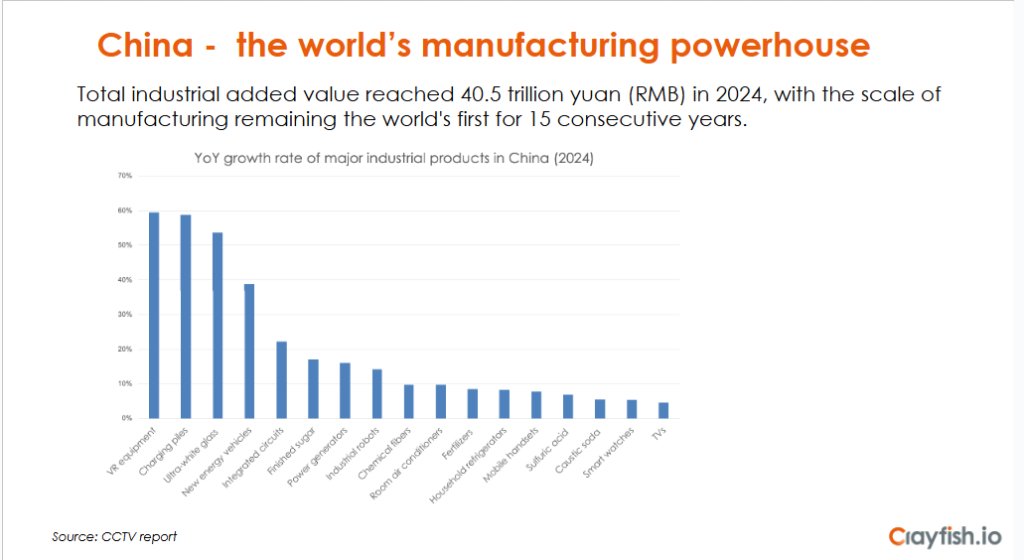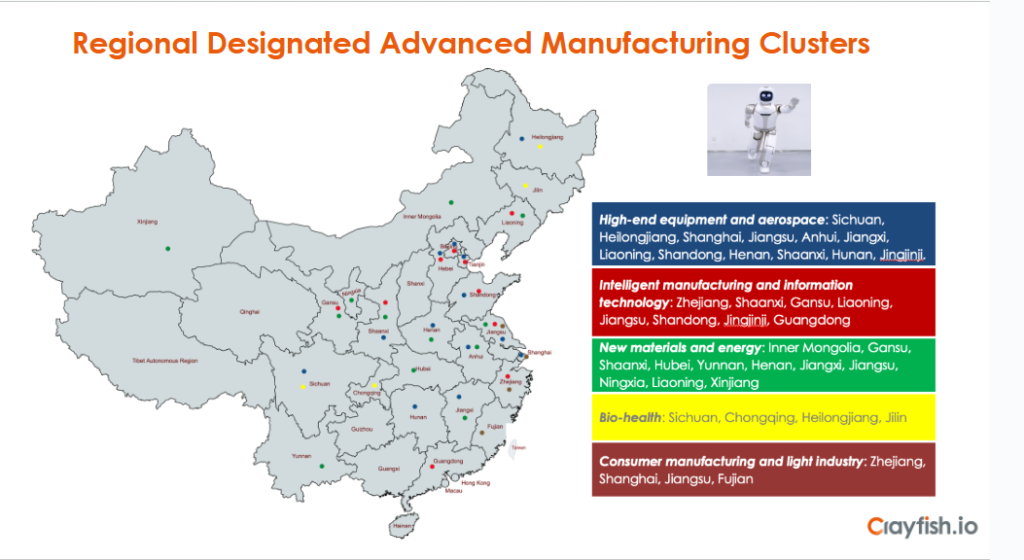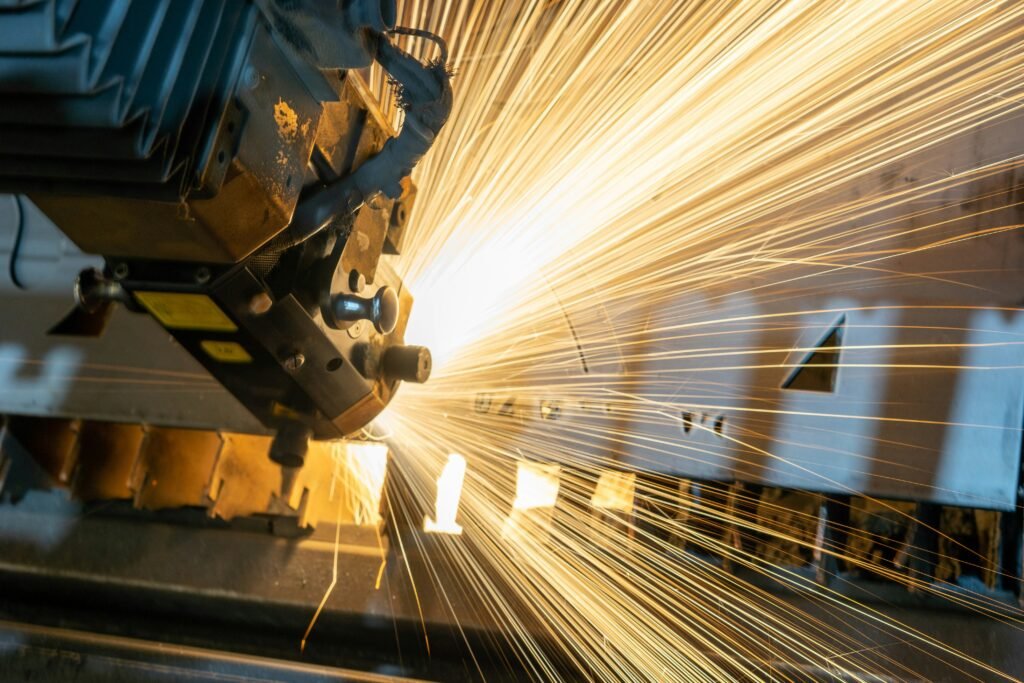China’s manufacturing sector remains a global leader, offering immense opportunities for businesses. This article explores the evolving landscape of Chinese manufacturing, key strategies for setting up a factory, and a real-world case study, drawing on insights from Ting Zhang, Founder & CEO of Crayfish.io, shared during a Flanders-China Chamber of Commerce webinar.
The Powerhouse of Chinese Manufacturing
China’s manufacturing dominance is unmatched, holding the title of the world’s top industrial producer for 15 consecutive years. In 2024, its industrial output reached 40 trillion RMB (approximately 4 trillion Euros), driven by high-growth sectors like VR equipment, electric vehicles (EVs), and EV charging infrastructure, as reported by CCTV.
Historically, China lagged during the Western Industrial Revolution but has since surged ahead through strategic initiatives like Made in China 2025, launched in 2015. This policy has propelled China to lead in scale, capacity, and innovation, particularly in high-tech manufacturing and green technologies.Key Takeaway: China’s manufacturing sector is a critical driver of its economy, excelling in technological innovation, employment generation, and global competitiveness.
New Policies in 2023: Embracing “New Productive Forces”
In 2023, China introduced policies to diversify its manufacturing base, shifting from traditional industries like toys to smart manufacturing, high-end production, and green technologies. The concept of “new productive forces” (新质生产力 – xīn zhì shēngchǎnlì), introduced by Xi Jinping, emphasizes innovation in AI, IoT, robotics, and green manufacturing.

The Rise of Green Factories
China’s push for sustainability includes:
- Reduced use of toxic materials
- Increased recycling efforts
- Adoption of low-carbon energy sources
Currently, 6,500 green factories account for 20% of China’s manufacturing capacity, earning national-level certifications. This reflects China’s commitment to sustainable manufacturing and environmental responsibility.
Designated Manufacturing Clusters
China is expanding manufacturing hubs beyond coastal cities like Shanghai, Shenzhen, and the Pearl River Delta to Western, Central, and Northeastern provinces. This strategy balances regional development and enhances supply chain resilience.
However, global supply chain disruptions and geopolitical tensions have led some companies, like Volvo and Signify, to diversify production to regions like Belgium and emerging economies. Despite this, many European firms continue to invest in China, particularly in pharmaceuticals, electronics, and EVs, leveraging its cost advantages and market proximity.

Case Study: Setting Up a Manufacturing Plant in China
This case study, based on a Crayfish.io client project nearing completion in 2025, outlines a six-month plan for establishing a manufacturing facility in China.
Initial Evaluation and Strategic Decisions
The client, a UK tech company generating 30% of its revenue from China, aimed to increase its market share by 10% through localized production. Key decisions included:
- Choosing a new factory location over expanding their existing sales office.
- Opting for a dedicated facility rather than subcontracting, due to the high-quality, low-volume nature of their product.
Localizing production and supply chains allowed the client to meet local pricing demands while maintaining high-end production in the UK.
In this specific case, our client’s product is high-quality but low-volume and it made much more sense for them to set up a small China manufacturing assembly operation that could meet their precise needs.
Further Reading: How to choose the right Chinese supplier?
The Work Plan: A Six-Month Sprint
The project was divided into two phases:
- Planning: Comprehensive evaluation of location, supply chain, and regulatory requirements.
- Execution: Setting up the entity, hiring staff, and preparing the site.
A cultural workshop was conducted for the client’s 15-member team to enhance communication skills with Chinese counterparts while protecting intellectual property (IP).

Choosing the Right Location
Selecting the optimal location involved evaluating:
- Economic Profile: Ensuring alignment with the client’s high-tech manufacturing needs.
- Local Supply Chain: Proximity to suppliers to reduce logistics costs.
- Logistics Infrastructure: Access to export markets like India and ASEAN countries.
- Operational Expenditure (OpEx): Assessing costs, including salaries and social insurance in cities like Dongguan, which offers lower costs than tier-one cities.
Industrial zones were compared based on infrastructure, vibrancy, and neighboring businesses. The client chose an established park in Dongguan for its robust ecosystem, avoiding underdeveloped zones with grand but unfulfilled promises.
Pro Tip: Opt for upper-floor manufacturing spaces in China’s “manufacturing goes upstairs” initiative for cost savings, provided they support your equipment needs. Renting upstairs is significantly cheaper, and it offers more choices as ground-floor spaces are always in short demand.
Building Local Government Relationships (Guanxi)
Establishing guanxi (关系) with local authorities is critical. For example, Tesla’s Shanghai Gigafactory was built in under a year due to strong ties with Shanghai’s government. In this case, Crayfish.io leveraged connections in Dongguan to engage the mayor’s office early, securing support and expediting approvals.
Our advice is to establish such a relationship right at the beginning of your China manufacturing project, to help ensure your new China operation is up and running smoothly.
External Resource: How Tesla Built Its Shanghai Gigafactory
Assembling the Right Team
The most crucial element in any overseas operation is the people. How do you ensure you get the right team, especially when you’re aiming for a very short timeframe?
Hiring began early, with the factory manager recruited within three months using platforms like BOSS Zhipin for senior roles and local job centers for workers. Key hiring strategies we have applied for this client included:
- Rapid hiring: Verbal offers within two days, formal offers within a week.
- Cultural integration: Training in the UK to align staff with company culture.
- Compliance with labor laws: Adhering to China’s probation period regulations.
Read the Case Study: Adding a local engineer to support EMEA
Licensing and Compliance
A China manufacturing business license requires listing all product parts explicitly to avoid lengthy amendments. The application process, while seemingly quick (two months), demands meticulous preparation by the team at headquarters to meet China’s strict compliance standards. Consulting on holding structures, tax implications and physical goods flows during the project planning stage can optimize costs and logistics, saving unnecessary re-adjustments at later stage.
Read the Case Study: Artistry meets innovation in China
Conclusion
Setting up manufacturing in China requires strategic planning and local expertise. By aligning with China’s “new productive forces,” leveraging green manufacturing, and building strong local relationships, businesses can thrive in this dynamic market. Crayfish.io’s case study demonstrates the importance of location selection, team-building, and compliance for success.
About Crayfish.io
Crayfish.io supports businesses in navigating China’s complex market through strategic consulting, IP protection, and tailored eServices. Launched in 2017, our digital platform offers fixed-price solutions for cross-border operations in China, the UK, and Europe.
Ready to explore manufacturing in China? Visit Crayfish.io for expert guidance.

